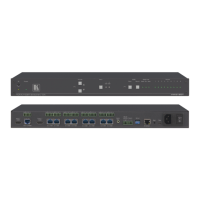VM-218DTxr, VM-218DT – Protocol 3000
Set protocol permission.
When the permission
system is enabled,
LOGIN enables running
commands with the User
or Administrator
permission level
When set, login must be
performed upon each
connection
The permission system
works only if security is
enabled with the
“SECUR” command.
It is not mandatory to
enable the permission
system in order to use the
device
In each device, some
connections allow logging
in to different levels.
Some do not work with
security at all.
Connection may logout
after timeout.
COMMAND
#LOGINlogin_level,password<CR>
FEEDBACK
~nn@LOGINlogin_level,passwordOK<CR><LF>
or
~nn@LOGINERR004<CR><LF>
(if bad password entered)
login_level – Level of permissions
required (User or Admin)
password – Predefined password (by
PASS command). Default password is
an empty string
Set the protocol permission
level to Admin (when the
password defined in the PASS
command is 33333):
#LOGINAdmin,33333<CR>
Get current protocol
permission level.
For devices that
support security, LOGIN
allows the user to run
commands with an End
User or Administrator
permission level.
In each device, some
connections allow logging
in to different levels.
Some do not work with
security at all.
Connection may logout
after timeout.
The permission system
works only if security is
enabled with the
“SECUR” command.
COMMAND
#LOGIN?<CR>
FEEDBACK
~nn@LOGINlogin_level<CR><LF>
login_level – Level of permissions
required (User or Admin)
Get the LOGIN definition:
#LOGIN?<CR>
Cancel current
permission level.
Logs out from User or
Administrator permission
levels to Not Secure.
COMMAND
#LOGOUT<CR>
FEEDBACK
~nn@LOGOUTOK<CR><LF>
Get device model.
This command
identifies equipment
connected to Step-in
master products and
notifies of identity
changes to the connected
equipment. The Matrix
saves this data in
memory to answer
REMOTE-INFO requests.
COMMAND
#MODEL?<CR>
FEEDBACK
~nn@MODELmodel_name<CR><LF>
model_name – String of up to 19
printable ASCII chars
Get the device model:
#MODEL?<CR>
COMMAND
#MUTEchannel,mute_mode<CR>
FEEDBACK
~nn@MUTEchannel,mute_mode<CR><LF>
channel – 1 (Output number)
mute_mode – On/Off
0 – Off
1 – On
Set speaker output to mute:
#MUTE1,1<CR>
COMMAND
#MUTE?channel<CR>
FEEDBACK
~nn@MUTEchannel,mute_mode<CR><LF>
channel – 1 (Output number)
mute_mode – On/Off
0 – Off
1 – On
Get mute status of output 1
#MUTE1?<CR>
Set machine (DNS)
name.
The machine name is
not the same as the
model name. The
machine name is used to
identify a specific
machine or a network in
use (with DNS feature
on).
COMMAND
#NAMEmachine_name<CR>
FEEDBACK
~nn@NAMEmachine_name<CR><LF>
machine_name – String of up to 15
alpha-numeric chars (can include
hyphen, not at the beginning or end)
Set the DNS name of the
device to room-442:
#NAMEroom-442<CR>
Get machine (DNS)
name.
The machine name is
not the same as the
model name. The
machine name is used to
identify a specific
machine or a network in
use (with DNS feature
on).
COMMAND
#NAME?<CR>
FEEDBACK
~nn@NAMEmachine_name<CR><LF>
machine_name – String of up to 15
alpha-numeric chars (can include
hyphen, not at the beginning or end)
Get the DNS name of the
device:
#NAME?<CR>

